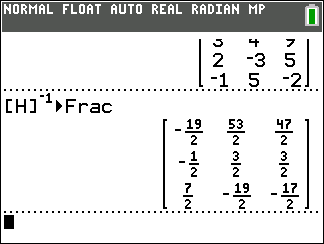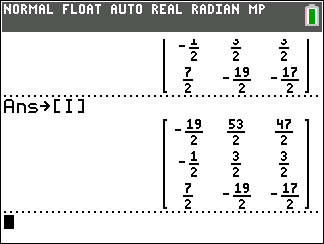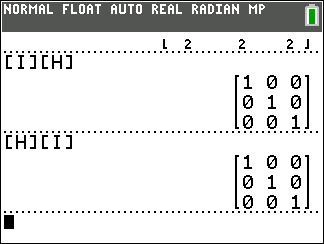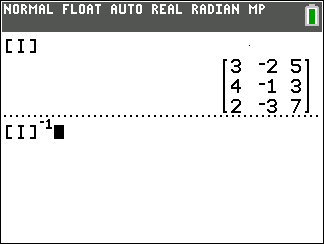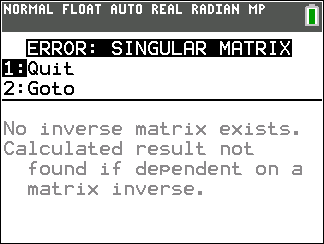
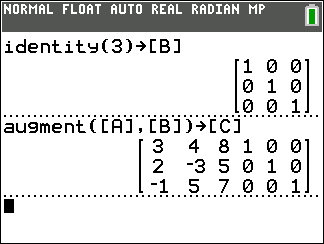
3 x 3
identity matrix and storing that in [B].
Then we go forward and paste the two matrices together to form a new
3 x 6 matrix which we store in [C].
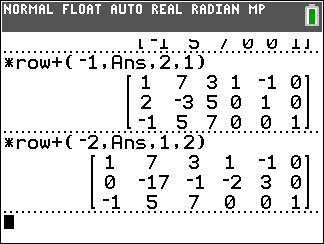
3 x 3
matrix.
Looking back at the lower half of Figure 02 we see that if we multiply row 2 by -1 and then add that to row 1 we will create a 1 in the first row, first column position. Our
3 x 6 matrix at the end of Figure 02
is not only stored in [C] but also stored in Ans.
We will just work on the version stored in Ans.
The command
*row+(-1,Ans,2,1) does that operation, and it shows the
resulting new value of Ans in the top halpf of Figure 03.
Next we want to genreate 0's below that 1. The first one we do is take -2 times row 1 and add it to row two. That command is
*row+(-2,Ans,1,2) and the
lower half of Figure 03 gives us the result.
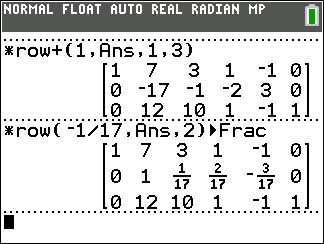
*row(1,Ans, 1,3).
With that command we have completed the taks of getting 0's below the 1 in row 1, column 1. Next we need to get a 1 in the second row, second column. Currently there is a -17 there. One way to make that value into a 1 is to multiply the row by -1/17. That is the gist of the next command shown in the middle of Figure 04,
*row(-1/17,Ans,2). Notice that we have added the  to the command so that the calculator displays the result as fractions where possible.
The result shows that we were successful.
to the command so that the calculator displays the result as fractions where possible.
The result shows that we were successful.
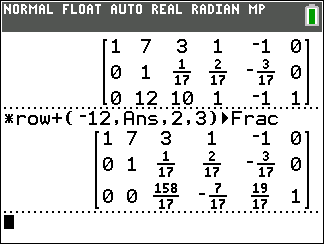
*row+(12,Ans,2,3).
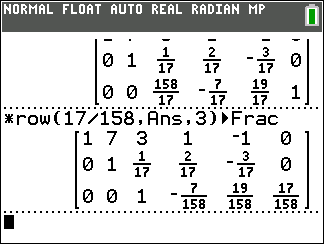
*row(17/158,Ans,3).
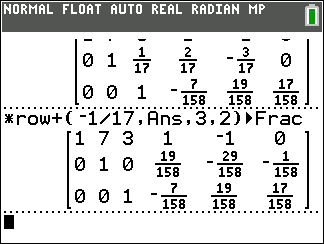
Back in Figure 06 we see that we have 1/17 in the second row third column. We can make that a 0 with the command
*row+(-1/17,Ans,3,2).

*row+(-3,Ans,3,1).
That will complete our work in the third column.
After that we move back to the second column.
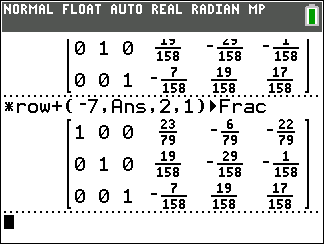
*row+(-7,Ans,2,1).
Once that is done we have finished our work. We have the identity matrix in the first three columns. The last three columns hold the inverse of the original matrix.
In the "old days" when we had to do this all by hand we would just copy those final three columns as our
3 x 3 inverse matrix.
There is no "nice" single command to
pull out those columns on the calculator although
after we see the short way of
getting the inverse, in Figure 10, we will look at
some ways to do this without copying
each of the values.
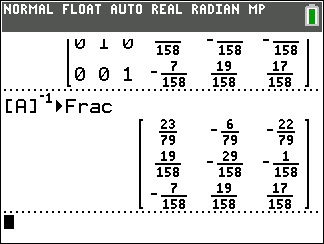
3 x 3 matrix.
To get the TI-83/84 calculators to perform that program you just need to give the name of the
original matrix folowed by the "reciprocal sign",
the -1 that is displayed
when we press the  key. That is the command, followed by the
key. That is the command, followed by the
 command, that you see in
Figure 10.
command, that you see in
Figure 10.
That one command produces the desired result.

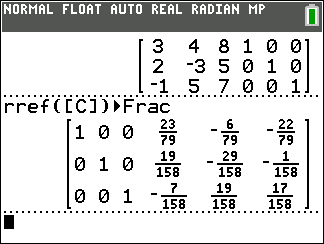
rref( process on the matrix. [Recall that such a
process is the "reduced row-eschelon form.]
In Figure 12 we see that using the
rref(
function had us go from what we had back in Figure 02
to the solution that we found in Figure 09.
Of course, we still have the answer as part of a
3 x 6 matrix here.
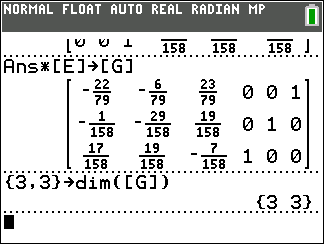
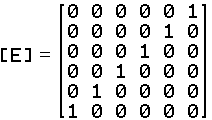 . That
. That 6 x 6 matrix,
as ou see, is all o's except for the
values in the "backwards" diagonal, which are all set to 1.
Figure 13 shows the result of multiplying the answer, Ans, of Figure 12 by [E] (on the right). what you see is that the result is just the old answer of Figure 12 but flipped left to right. By oing this we have placed the "flipped" version of the nverse matrix into the first three columns of our
3 x 6 matrix.
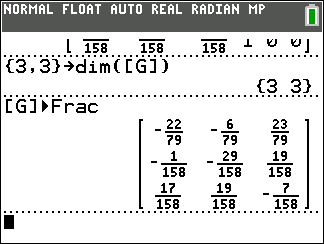
{3,3}→dim([G]) will change [G]
to a 3 x 3 matrix, retaining the first three columns.
The subsequent command just displays our new [G].
It contains the flipped version of the inverse matrix.
All we need to do is to flip it back.
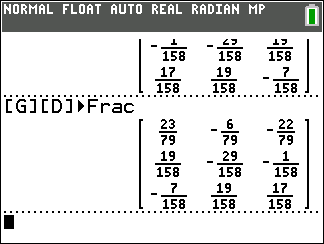
 . We just have to multiply [G]
by [D], on the right, to flip it again left to right.
The result is exactly the inverse matrix that we want.
. We just have to multiply [G]
by [D], on the right, to flip it again left to right.
The result is exactly the inverse matrix that we want.

Figure 15.1 introduces a new matrix, [F], that is a somewhat strange
6 x 3 matrix.
Now the top half of the matrix is all 0 values and the
bottom is looks like the identity matrix.
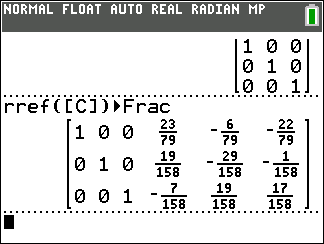
3 x 6 matrix
answer.
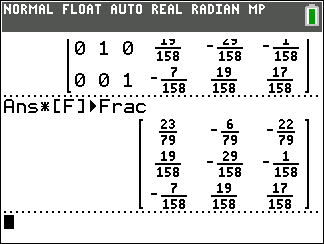
3 x 3 matrix.

